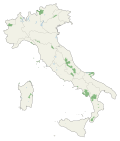| Dolomites | |
|---|---|
| Italian: Dolomiti Ladin: Dolomites German: Dolomiten | |
 Tofana massif with Cortina d'Ampezzo in the foreground | |
| Highest point | |
| Peak | Marmolada |
| Elevation | 3,343 m (10,968 ft) |
| Coordinates | 46°26′N11°51′E / 46.433°N 11.850°E |
| Dimensions | |
| Area | 15,942 km2 (6,155 sq mi) |
| Geography | |
| Country | |
| Regions | |
| Parent range | Alps |
| Geology | |
| Orogeny | Alpine orogeny |
| Rock age | Mostly Triassic |
| Rock types | |
| UNESCO World Heritage Site | |
|---|---|
 | |
 Interactive map of The Dolomites | |
| Criteria | Natural: (vii)(viii) |
| Reference | 1237 |
| Inscription | 2009 (33rd Session) |
| Area | 141,902.8 ha |
| Buffer zone | 89,266.7 ha |
The Dolomites [a] or Pale Mountains (Italian : Monti Pallidi) are a mountain range in northeastern Italy. They form part of the Southern Limestone Alps and extend from the River Adige in the west to the Piave Valley (Pieve di Cadore) in the east. The northern and southern borders are defined by the Puster Valley and the Sugana Valley (Italian: Valsugana). The Dolomites are in the regions of Veneto, Trentino-Alto Adige/Südtirol and Friuli-Venezia Giulia, [2] covering an area shared between the provinces of Belluno, Vicenza, Verona, Trentino, South Tyrol, Udine and Pordenone.
Contents
- Etymology
- History
- Geography
- Current classification
- Tourism and sports
- Major peaks
- Major passes
- Major parks
- See also
- References
- Bibliography
- External links
Other mountain groups of similar geological structure are spread along the River Piave to the east—Dolomiti d'Oltrepiave; and far away over the Adige River to the west— Dolomiti di Brenta (Western Dolomites). A smaller group is called Piccole Dolomiti (Little Dolomites), between the provinces of Trentino, Verona and Vicenza.
The Dolomiti Bellunesi National Park and many other regional parks are in the Dolomites. On 26 June 2009, the Dolomites were declared a UNESCO World Heritage Site. [3] [4] The Adamello-Brenta UNESCO Global Geopark is also in the Dolomites. [5] The Geological Museum of the Dolomites (in Italian Museo Geologico delle Dolomiti) is located in Predazzo, Fiemme Valley.





